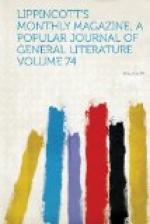At the rear of the same “Row” we recognized a broad-hatted figure once familiar to us in the Quartier Latin and the artistic auberges of the Forest of Fontainebleau. The very personification of insouciance and laissez-aller, he whose tiny bedroom-studio up-stairs ran riot with color caught among California mountains, in cool gray France and ochreous England, was bending the whole force of his mind to sketching a pouter pigeon preening itself upon a barrel.
Still another of the ugly cottages, cursed by artists but inhabited by them, was hired at ten pounds a year by two young landscapists. A charwoman came every morning to quell the mad riots in which the household gods (or demons) diurnally engaged, but at all other times the landscapists manoeuvred for themselves. That the domestic manoeuvring of young landscapists is not always toute rose we saw reason later to believe. For not once, twice, nor yet so seldom as a dozen times, have we seen these young manoeuvrers begin to dine at four, when shadows were growing too long upon field, thicket, and stream, only to finish we knew not when, so late into darkness was that “finish” projected. We could see one of the diners passing along the road from the public house, an eighth of a mile away, at four, with the piece de resistance of the meal in an ample dish enveloped in a towel. Ten minutes later the other rushes by, contrariwise of direction, in pursuit of beer and the forgotten bread. A little later, and a scudding white dust-cloud in the road informs us that one of the dining ’scapists flees breathlessly vinegar- or salt-ward. Still another five minutes, and the other diner hies him in chase of the white scud, calling vigorously to it that there is no butter for the rice, no sugar for the fruit.
We saw at once that this Berkshire corner abounds more in dulcet and sylvan landscape bits than in picturesque motifs for those who paint genre. The peasants have a certain inchoate picturesqueness, as of beings roughly evolved from the life of this fair material nature, and sometimes, in silhouette against dun-gray skies and amid rugged fields, give one vague feeling of Millet’s pathos of peasant life and labor. The yokel himself, however,—and particularly herself,—seems determined to deny all poetic and picturesque relations, by clothing himself—and herself—in coarse, shop-made rubbish, in battered, demode town-hats and flounced gowns from Petticoat Lane.
From certain points of the “Dean” the distances are dreamy and wide, with high horizon-lines touching wooded hills and shutting the Thames into a middle distance toward which a hundred little hills either descend abruptly or decline gently upon broad green meadows. Nature here smiles, not with pure pagan blitheness, but with a tenderer grace, as of a soul grown human and fraught with countless memories of man’s smiles and tears, his hard, bitter labor, his sins, sorrows, and longings. But it is very tender, and not even the wildest storm-effects raise the landscape to any expression of tragic grandeur, but only suede its fair hues and soft outlines to the wan pathos peculiar to English moorlands.




